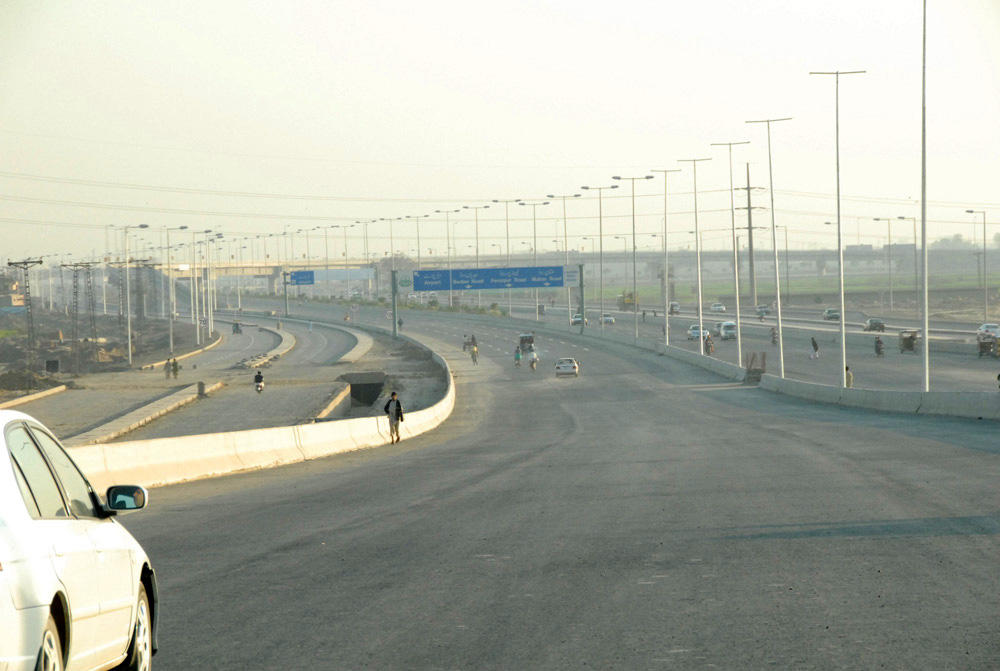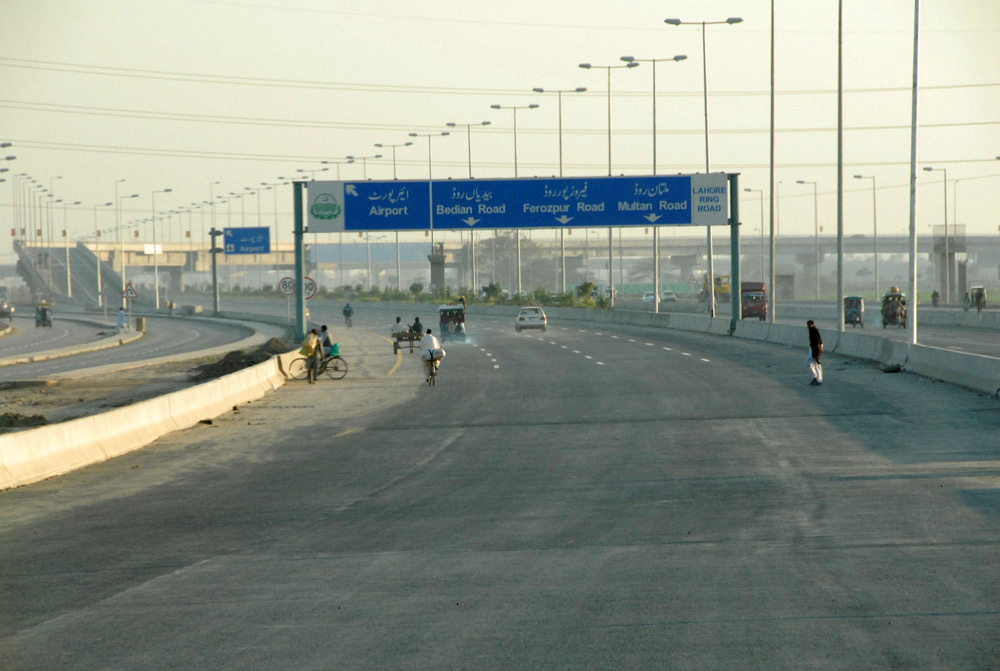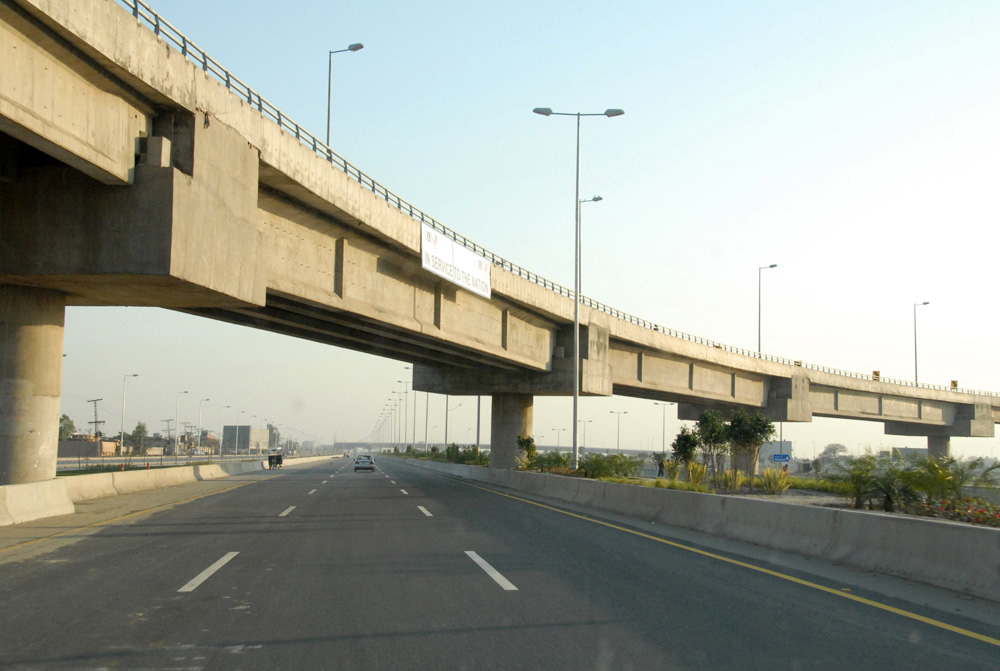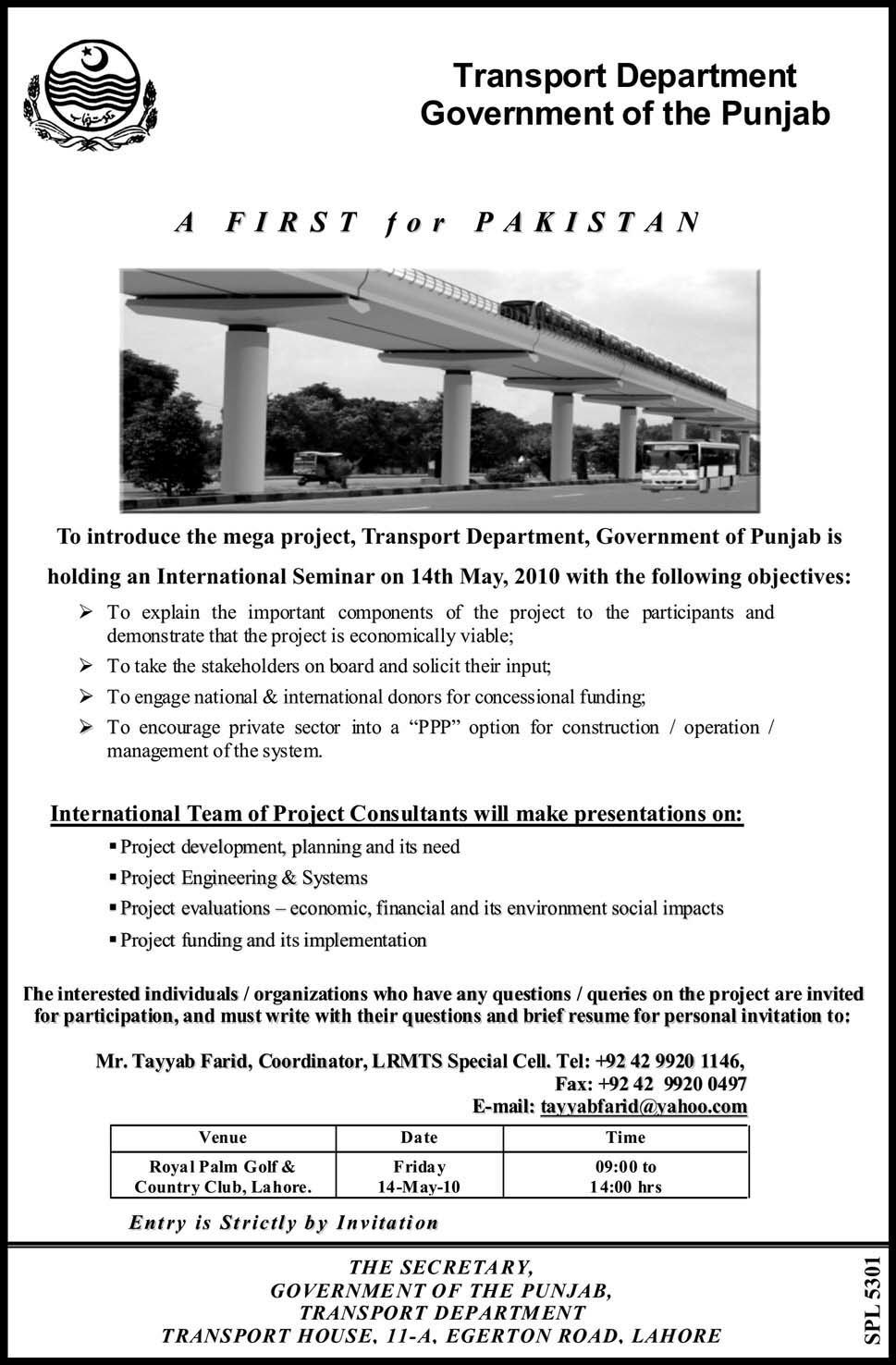How to install the app on iOS
Follow along with the video below to see how to install our site as a web app on your home screen.
Note: This feature may not be available in some browsers.
You are using an out of date browser. It may not display this or other websites correctly.
You should upgrade or use an alternative browser.
You should upgrade or use an alternative browser.
Pakistan's Infrastructure & Development- Updates & Discussions.
- Thread starter EagleEyes
- Start date
SHAMK9
SENIOR MEMBER

- Joined
- Mar 5, 2010
- Messages
- 6,095
- Reaction score
- 4
- Country
- Location
A very well done job by the Pakistan transport authority!
thats the way pakistan roles



sparklingway
SENIOR MEMBER

- Joined
- May 12, 2009
- Messages
- 3,878
- Reaction score
- 0
National Assembly Session May 7, 2010 :-
79. *Ms. Qudsia Arshad:
Will the Minister for Defence be pleased to state the present status of
the New Benazir Bhutto International Airport (NBBA), Islamabad
alongwith the time by which it will be completed?
Minister for Defence (Ch. Ahmad Mukhtar): The works on the New
Benazir Bhutto International Airport Project (NBBIA) are presently in progress
with anticipated date of completion as 31-12-2012.
bc040400065
FULL MEMBER

- Joined
- Feb 24, 2010
- Messages
- 1,092
- Reaction score
- 0
- Country
- Location
Provinces have major share in Rs663bn PSDP
By Khaleeq Kiani
Saturday, 29 May, 2010
ISLAMABAD: The National Economic Council (NEC) approved on Friday Rs280 billion for federal development programmes for the next financial year about 33 per cent lower than current years allocation of Rs421 billion and set an economic growth rate target of 4.5 per cent.
The size of the overall Public Sector Development Programme (PSDP) for 2010-11 was set at Rs663 billion, with an allocation of Rs373 billion for provinces.
An amount of Rs10 billion was allocated for the Earthquake Rehabilitation and Reconstruction Authority 60 per cent less than the current years original allocation of Rs25 billion that was later curtailed to Rs10 billion.
The NEC meeting presided over by Prime Minister Yousuf Raza Gilani and attended by chief ministers, the AJK prime minister and federal and provincial ministers also reviewed current years Development Programme that had been slashed by about 25 per cent to Rs490 billion from the budgetary allocation of Rs646 billion.
Briefing reporters after the meeting, Prime Ministers Adviser on Finance and Revenue Dr Abdul Hafeez Shaikh said the main focus of next years PSDP would be on completion of ongoing projects rather than starting new ones.
The PSDP will include a foreign exchange component of Rs78 billion, including Rs38 billion for federal programmes.
The adviser said the flow of resources would shift to provinces after the new National Finance Commission award and 18th Amendment.
He said the size of the federal PSDP set at Rs280 billion was about 25 per cent higher than current years revised estimates of Rs235 billion but 37 per cent lower than the original allocation of Rs446 billion.
The provinces will get about 52 per cent higher allocation of Rs373 billion for next years development programme when compared with current years revised estimates of Rs245 billion and 21 per cent higher than the original estimates of Rs294 billion.
Mr Shaikh said the NEC had decided to ensure that the entire amount was released and utilised for all approved projects under a quarterly automatic mechanism rather than giving discretionary powers to the finance ministry to stop releases as the year progressed. These are challenging things for a political government but realistic to ensure that benefits of development reach the people, he said.
The adviser said the objective of the federal programme would be to develop backwards areas and remove regional disparities at the provincial level. He said the provincial governments would also be advised to narrow down inequalities within their regions.
He said the government would ensure that the entire allocation for development was utilised through improved monitoring with the help of modern technology.
He said the NEC would meet every four months to review and rationalise progress.
The adviser said the government would try to curtail current expenditure. Fiscal austerity will be the big theme of this years budget. Infrastructure and social services would get the biggest allocations of Rs136 billion and Rs134 billion, he said. An amount of Rs65.4 billion will be allocated for energy and water sectors. Health and education will get Rs19 billion and Rs21 billion, respectively. Planning Commissions Deputy Chairman Dr Nadeemul Haque said the NEC had also approved next years programme that envisaged a GDP (gross domestic product) growth rate of 4.5 per cent, against current years revised estimate of 4.1 per cent.
This will be backed by 4.7 per cent growth in the services sector, 3.8 per cent in agriculture and 5.2-5.6 per cent in manufacturing.
Finance Secretary Salman Siddique said that current years development programme had to be curtailed because of higher security expenditure and a breakdown in inflows from the United States under the Coalition Support Fund. He said the CSF funds had started to flow now.
Responding to a question about the Multan and Larkana development packages announced by the prime minister and the president, Mr Shaikh said it was not unique with the current government to announce special development packages, but this should not be a dominant style.
He said the economic survey for the current year would be released on June 4 and the federal budget would be announced on June 5.
DAWN.COM | Front Page | Provinces have major share in Rs663bn PSDP
By Khaleeq Kiani
Saturday, 29 May, 2010
ISLAMABAD: The National Economic Council (NEC) approved on Friday Rs280 billion for federal development programmes for the next financial year about 33 per cent lower than current years allocation of Rs421 billion and set an economic growth rate target of 4.5 per cent.
The size of the overall Public Sector Development Programme (PSDP) for 2010-11 was set at Rs663 billion, with an allocation of Rs373 billion for provinces.
An amount of Rs10 billion was allocated for the Earthquake Rehabilitation and Reconstruction Authority 60 per cent less than the current years original allocation of Rs25 billion that was later curtailed to Rs10 billion.
The NEC meeting presided over by Prime Minister Yousuf Raza Gilani and attended by chief ministers, the AJK prime minister and federal and provincial ministers also reviewed current years Development Programme that had been slashed by about 25 per cent to Rs490 billion from the budgetary allocation of Rs646 billion.
Briefing reporters after the meeting, Prime Ministers Adviser on Finance and Revenue Dr Abdul Hafeez Shaikh said the main focus of next years PSDP would be on completion of ongoing projects rather than starting new ones.
The PSDP will include a foreign exchange component of Rs78 billion, including Rs38 billion for federal programmes.
The adviser said the flow of resources would shift to provinces after the new National Finance Commission award and 18th Amendment.
He said the size of the federal PSDP set at Rs280 billion was about 25 per cent higher than current years revised estimates of Rs235 billion but 37 per cent lower than the original allocation of Rs446 billion.
The provinces will get about 52 per cent higher allocation of Rs373 billion for next years development programme when compared with current years revised estimates of Rs245 billion and 21 per cent higher than the original estimates of Rs294 billion.
Mr Shaikh said the NEC had decided to ensure that the entire amount was released and utilised for all approved projects under a quarterly automatic mechanism rather than giving discretionary powers to the finance ministry to stop releases as the year progressed. These are challenging things for a political government but realistic to ensure that benefits of development reach the people, he said.
The adviser said the objective of the federal programme would be to develop backwards areas and remove regional disparities at the provincial level. He said the provincial governments would also be advised to narrow down inequalities within their regions.
He said the government would ensure that the entire allocation for development was utilised through improved monitoring with the help of modern technology.
He said the NEC would meet every four months to review and rationalise progress.
The adviser said the government would try to curtail current expenditure. Fiscal austerity will be the big theme of this years budget. Infrastructure and social services would get the biggest allocations of Rs136 billion and Rs134 billion, he said. An amount of Rs65.4 billion will be allocated for energy and water sectors. Health and education will get Rs19 billion and Rs21 billion, respectively. Planning Commissions Deputy Chairman Dr Nadeemul Haque said the NEC had also approved next years programme that envisaged a GDP (gross domestic product) growth rate of 4.5 per cent, against current years revised estimate of 4.1 per cent.
This will be backed by 4.7 per cent growth in the services sector, 3.8 per cent in agriculture and 5.2-5.6 per cent in manufacturing.
Finance Secretary Salman Siddique said that current years development programme had to be curtailed because of higher security expenditure and a breakdown in inflows from the United States under the Coalition Support Fund. He said the CSF funds had started to flow now.
Responding to a question about the Multan and Larkana development packages announced by the prime minister and the president, Mr Shaikh said it was not unique with the current government to announce special development packages, but this should not be a dominant style.
He said the economic survey for the current year would be released on June 4 and the federal budget would be announced on June 5.
DAWN.COM | Front Page | Provinces have major share in Rs663bn PSDP
Hyde
SENIOR MODERATOR

- Joined
- Oct 20, 2008
- Messages
- 20,543
- Reaction score
- 20
- Country
- Location
Railways launches 530 high speed hi-capacity wagons making project
RECORDER REPORT
LAHORE (May 29 2010): Pakistan Railways has launched a project of manufacturing of 530 high speed hi-capacity wagons with an estimated cost of Rs 4.1 billions. These wagons can run up to 100 kilometer per hour either loaded or empty. These wagons can lift maximum of 61 tons of goods per wagon and out of these 344 are high-sided wagons, 156 container wagon and 30 break wagons.
Islamic Bank Jeddah has provided US 39.07 million dollars foreign exchange as loan for this project. Material for these wagons had been imported from China while these were being manufactured in Mughalpura workshops of the Pakistan Railways. First rack of 25 high speed hi-capacity wagons was inaugurated by the General Manager (Operations) Muhammad Ashfaq Khattak at Lahore Cantonment station here on Friday.
The rack is on its first trial run between Lahore and Karachi. A large number of railway officers and staff attended the ceremony. According to a spokesman, Pakistan Railways is paying special attention on goods train to reduce its deficit. It direly needs high speed latest wagons and locomotives to improve its goods services so as to make it competitive with the road transport. Efforts are being made to complete this project by December 2010.
SHAMK9
SENIOR MEMBER

- Joined
- Mar 5, 2010
- Messages
- 6,095
- Reaction score
- 4
- Country
- Location
thats not high speed train the speed trains go up to 300 -400 km per hourRailways launches 530 high speed hi-capacity wagons making project
RECORDER REPORT
LAHORE (May 29 2010): Pakistan Railways has launched a project of manufacturing of 530 high speed hi-capacity wagons with an estimated cost of Rs 4.1 billions. These wagons can run up to 100 kilometer per hour either loaded or empty. These wagons can lift maximum of 61 tons of goods per wagon and out of these 344 are high-sided wagons, 156 container wagon and 30 break wagons.
Islamic Bank Jeddah has provided US 39.07 million dollars foreign exchange as loan for this project. Material for these wagons had been imported from China while these were being manufactured in Mughalpura workshops of the Pakistan Railways. First rack of 25 high speed hi-capacity wagons was inaugurated by the General Manager (Operations) Muhammad Ashfaq Khattak at Lahore Cantonment station here on Friday.
The rack is on its first trial run between Lahore and Karachi. A large number of railway officers and staff attended the ceremony. According to a spokesman, Pakistan Railways is paying special attention on goods train to reduce its deficit. It direly needs high speed latest wagons and locomotives to improve its goods services so as to make it competitive with the road transport. Efforts are being made to complete this project by December 2010.
Hyde
SENIOR MODERATOR

- Joined
- Oct 20, 2008
- Messages
- 20,543
- Reaction score
- 20
- Country
- Location
thats not high speed train the speed trains go up to 300 -400 km per hour
You are talking about Bullet Trains - this is something else....... though the title is a bit misleading
faisaljaffery
FULL MEMBER

- Joined
- Mar 28, 2010
- Messages
- 314
- Reaction score
- 0
Lahore ring road is a impressive project. i will like to drive on the new route in my next visit to Lahore
Hyde
SENIOR MODERATOR

- Joined
- Oct 20, 2008
- Messages
- 20,543
- Reaction score
- 20
- Country
- Location
Lack of double taxation treaty: PIA incurring loss of Rs 40,000 per Kabul flight
KARACHI (June 21 2010): The Pakistan International Airlines Corporation (PIAC) is incurring a loss of Rs 40,000 on each flight from Islamabad to Kabul, owing to the absence of double taxation treaty between Pakistan and Afghanistan.
Sources told Business Recorder on Saturday that the issue was highlighted by the officials of the national flag carrier at a meeting with the chairman of the Federal Board of Revenue (FBR) some time early this month in Islamabad.
They said that the PIAC has been paying 25 percent corporate tax and 10 percent business receipt tax (BRT) on its gross sales to the Afghan officials, which results in a loss of Rs 40,000 on each flight from Islamabad to Kabul.
They said that although the government could not stop the flights to Afghanistan because of strategic reasons, it could enter into a double taxation treaty to get exemption on the levy on income of airlines of both countries.
Officials of national flag carrier had further informed the FBR chief that Indian government had finalised similar treaty with Afghanistan to avoid such revenue losses.
Commenting on value-added tax (VAT) implementation, the office-bearers of PIAC said that although the implementation of VAT on international transport services had been withheld for the time being, it would result in drastic implications for the airline on implementation in future.
They said that foreign carriers, lifting passengers from Pakistan to their hubs, mainly in Gulf, would have the facility of issuing tickets from Pakistan to their hubs and collecting applicable VAT only for this travel.
Moreover, they said, the tickets for the remaining part of the travel from their hubs to other destinations in the world would be issued out of Pakistan and, therefore, these tickets would be much cheaper than the tickets of PIA, involving VAT for the full itinerary.
They said that the foreign airlines would start issuing tickets from their hubs in Gulf and make the passengers travel from Pakistan without involving any VAT, thereby depriving the government of Pakistan of its revenue, and putting PIAC in an uncompetitive position.
xenia
FULL MEMBER

- Joined
- Jan 24, 2010
- Messages
- 785
- Reaction score
- 0
Centaurus Tower faces uncertain future
By Imran Ali Teepu
Tuesday, 14 Sep, 2010
ISLAMABAD, Sept 13: The countrys first mix-use complex being built in the federal capital faces an uncertain future as its management and the Capital Development Authority (CDA) have developed serious differences over provision of services, resulting in withholding of payment amounting to around Rs1 billion to the latter, it has been learnt.
Centaurus Tower is located at F-8 Sector in the confluence of Jinnah and Faisal avenues. The $350 million tower comprises an international standard mega mall, ultra-luxurious apartments and penthouses, modern corporate offices and a high-end deluxe hotel. The tower is planned to have 37 storeys.
An official said CDAs under-performing financial wing had made several attempts to get the blocked amount cleared but the stance of the towers management was clear that the money would be released after provision of utility facilities.
Though the civic agency is facing financial crisis, he said, it was under an agreement to ensure supply of water, electricity and other utility services. However, since the start of the construction work three years back, the CDA has not fulfilled its commitment in this regard.
An official privy to the development told Dawn that the management of Centaurus had held back three installments of payment amounting to Rs650 million on the pretext of non-provision of utility services. Besides, the company also owes Rs300 million to the CDA in return for a plot, they added.
In January this year, the towers management informed the civic agency that they needed around 16 megawatt electricity to energise the building.
The official said that as per laid-down policy of National Electric Power Regulatory Authority (Nepra), a grid station was required if the electricity consumption exceeded five megawatts.
As the construction of the project moved on, the cost of electricity supply to the building spreading over 6.95 acres also towered.
He said the cost of 20MW electricity supply, which was estimated at Rs252 million in 2007, had now shot up to Rs540 million, and these issues remained unsettled between the CDA and the builders.
Answering a question, he said: It is the job of the agency to lay the drainage facilities, sewage lines, storm water drainage, garbage collection and other civic facilities but all it has been doing is making promises to the foreign investor.
The builders have also complained to CDA over construction of Faisal Avenue Flyover near the building, terming it an intrusion into the privacy of the complex. He added: They [towers management] also informed the authority that the flyover had direct view into the swimming pool of the building, forcing the management to redesign it.
When approached, CDA spokesman Ramzan Sajid claimed: We have no issues with the towers management and the utility facilities will be provided to them very soon.
The authority, he said, had already selected a suitable location for the construction of the grid station and all the civic facilities, including electricity, would be provided to the building.
The CDA had auctioned the commercial plot to the Saudi company running a joint venture with a Pakistani construction firm since 2005. The authority had fetched a record price from the auctioning of the plot.
DAWN.COM | Islamabad | Centaurus Tower faces uncertain future
By Imran Ali Teepu
Tuesday, 14 Sep, 2010
ISLAMABAD, Sept 13: The countrys first mix-use complex being built in the federal capital faces an uncertain future as its management and the Capital Development Authority (CDA) have developed serious differences over provision of services, resulting in withholding of payment amounting to around Rs1 billion to the latter, it has been learnt.
Centaurus Tower is located at F-8 Sector in the confluence of Jinnah and Faisal avenues. The $350 million tower comprises an international standard mega mall, ultra-luxurious apartments and penthouses, modern corporate offices and a high-end deluxe hotel. The tower is planned to have 37 storeys.
An official said CDAs under-performing financial wing had made several attempts to get the blocked amount cleared but the stance of the towers management was clear that the money would be released after provision of utility facilities.
Though the civic agency is facing financial crisis, he said, it was under an agreement to ensure supply of water, electricity and other utility services. However, since the start of the construction work three years back, the CDA has not fulfilled its commitment in this regard.
An official privy to the development told Dawn that the management of Centaurus had held back three installments of payment amounting to Rs650 million on the pretext of non-provision of utility services. Besides, the company also owes Rs300 million to the CDA in return for a plot, they added.
In January this year, the towers management informed the civic agency that they needed around 16 megawatt electricity to energise the building.
The official said that as per laid-down policy of National Electric Power Regulatory Authority (Nepra), a grid station was required if the electricity consumption exceeded five megawatts.
As the construction of the project moved on, the cost of electricity supply to the building spreading over 6.95 acres also towered.
He said the cost of 20MW electricity supply, which was estimated at Rs252 million in 2007, had now shot up to Rs540 million, and these issues remained unsettled between the CDA and the builders.
Answering a question, he said: It is the job of the agency to lay the drainage facilities, sewage lines, storm water drainage, garbage collection and other civic facilities but all it has been doing is making promises to the foreign investor.
The builders have also complained to CDA over construction of Faisal Avenue Flyover near the building, terming it an intrusion into the privacy of the complex. He added: They [towers management] also informed the authority that the flyover had direct view into the swimming pool of the building, forcing the management to redesign it.
When approached, CDA spokesman Ramzan Sajid claimed: We have no issues with the towers management and the utility facilities will be provided to them very soon.
The authority, he said, had already selected a suitable location for the construction of the grid station and all the civic facilities, including electricity, would be provided to the building.
The CDA had auctioned the commercial plot to the Saudi company running a joint venture with a Pakistani construction firm since 2005. The authority had fetched a record price from the auctioning of the plot.
DAWN.COM | Islamabad | Centaurus Tower faces uncertain future
Karachiite
BANNED

- Joined
- May 1, 2010
- Messages
- 3,044
- Reaction score
- -2
- Country
- Location
By Strong Hearted
Lahore Ring Road





Lahore Ring Road





Last edited:
Aeon
FULL MEMBER

- Joined
- Feb 9, 2010
- Messages
- 398
- Reaction score
- 0
PM asks PR officials to change mindset
Tuesday, 28 Sep, 2010
ISLAMABAD: Prime Minister Yousuf Raza Gilani told the railway officials on Monday to change their mindset, transform the organisation and improve their performance to become eligible for financial assistance.
Pakistan Railways is among the state-owned entities selected for restructuring by the Cabinet Committee on Restructuring of SOEs.
Much time has passed and I have yet to see tangible results on ground, Mr Gilani said during a meeting with officials of the Ministry of Railways and Pakistan Railways. The meeting reviewed progress on implementation of the cabinet committees decision.
The prime minister said the government could not afford to throw good money after the bad money because it was facing serious financial challenges.
In the 21st century, Pakistan needs a railway system that is cheap, efficient, reliable and secure mode of communication, he said and asked the officials to enhance their operational efficiency and make the PR a profit-making organisation.
He asked Railways Minister Ghulam Ahmad Bilour and Finance Minister Abdul Hafeez Sheikh to work out a long-term plan to improve efficiency and financial viability of the railways department.
He said the Pakistan Railways should reclaim its old glory to become a preferred means of travelling for the common man. For achieving this goal, he added, PR must undergo total transformation.
Mr Gilani directed the cabinet committee to finalise restructuring proposals and place them before the cabinet at the earliest, adding that the proposals should have a clear and doable roadmap with timelines and specific targets.
In the meantime, he said, the PR should put its house in order and begin work on improving its management. He said the PR must focus on reducing operating costs by introducing innovation to increase earnings.
Tuesday, 28 Sep, 2010
ISLAMABAD: Prime Minister Yousuf Raza Gilani told the railway officials on Monday to change their mindset, transform the organisation and improve their performance to become eligible for financial assistance.
Pakistan Railways is among the state-owned entities selected for restructuring by the Cabinet Committee on Restructuring of SOEs.
Much time has passed and I have yet to see tangible results on ground, Mr Gilani said during a meeting with officials of the Ministry of Railways and Pakistan Railways. The meeting reviewed progress on implementation of the cabinet committees decision.
The prime minister said the government could not afford to throw good money after the bad money because it was facing serious financial challenges.
In the 21st century, Pakistan needs a railway system that is cheap, efficient, reliable and secure mode of communication, he said and asked the officials to enhance their operational efficiency and make the PR a profit-making organisation.
He asked Railways Minister Ghulam Ahmad Bilour and Finance Minister Abdul Hafeez Sheikh to work out a long-term plan to improve efficiency and financial viability of the railways department.
He said the Pakistan Railways should reclaim its old glory to become a preferred means of travelling for the common man. For achieving this goal, he added, PR must undergo total transformation.
Mr Gilani directed the cabinet committee to finalise restructuring proposals and place them before the cabinet at the earliest, adding that the proposals should have a clear and doable roadmap with timelines and specific targets.
In the meantime, he said, the PR should put its house in order and begin work on improving its management. He said the PR must focus on reducing operating costs by introducing innovation to increase earnings.
faisaljaffery
FULL MEMBER

- Joined
- Mar 28, 2010
- Messages
- 314
- Reaction score
- 0
Lahore Ring Road Project Looks Impresive.
Similar threads
- Article
- Replies
- 0
- Views
- 410
- Article
- Replies
- 0
- Views
- 230
- Replies
- 0
- Views
- 831





